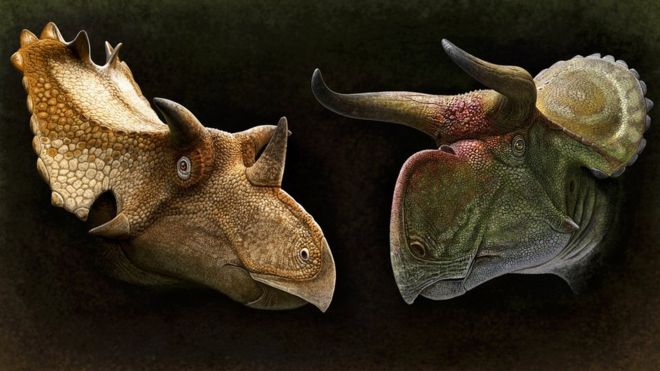
Dinosaurs like the Triceratops may have had horns and frills to attract a mate, a new study suggests.
Ceratopsian, or horned dinosaurs, were previously thought to have developed this ornamentation to distinguish between different species.
This has now been ruled out in a study published in a Royal Society journal.
Instead, the aggressive-looking armour may actually have evolved to signal an animal’s suitability as a partner, known as socio-sexual selection.
“Individuals are advertising their quality or genetic make-up,” explained Andrew Knapp, lead author of the research reported in Proceedings of the Royal Society B.
“We see that in peacocks too, with their tail feathers.”
Putting on a show
Features that can differentiate between species are usually less elaborate than those distinguishing males and females.
To prevent mating with other species, only subtle indications are needed. When the goal is to repel, not attract, it is not worth putting in the extra evolutionary effort.
The study’s original design was to determine whether the distinctive horns and frills of ceratopsian dinosaurs were for this inter-species purpose.
Previous research had ruled out their use for predator defence and regulating body temperature.
“It is exciting that dinosaur fossils are being examined more and more exhaustively in order to further understand their palaeobiology,” commented Dr Darla Zelenitsky, from the University of Calgary, Canada, who was not involved in the study.
Fossil records for all known ceratopsian species were analysed by location and time period.
“Some of these ornaments were also likely used at times for defence against predators or, to some extent, for recognition of members of different species, but these were apparently not the primary driver in their evolution,” added Dr Zelenitsky, who teaches palaeobiology.
Further work will now be done to test whether socio-sexual selection is the motivating factor behind the evolution of these ornaments.
Mr Knapp points out that there is not a massive amount of evidence for species recognition even in living animals. Instead, there may be some more innate understanding at work.
“Individuals within large herds such as reindeer don’t have trouble distinguishing their siblings,” the Queen Mary University of London, UK, researcher said.
Equal parenting
The study did find that male and female ceratopsian dinosaurs could not be distinguished from each other in the fossil record. If there were physical differences, they may have been very subtle.
“The fact that they both have these large ornaments is very interesting in itself. If it is sexual selection, that will tell us a lot about how these animals lived,” added Mr Knapp.
Ceratopsians are egg-laying, and the female does not need to carry young to term in the way that mammals do. This could point to a different breeding system with more mate co-operation.
“Possibly they’re both quite invested in raising their young, like we see in birds,” said Mr Knapp.
